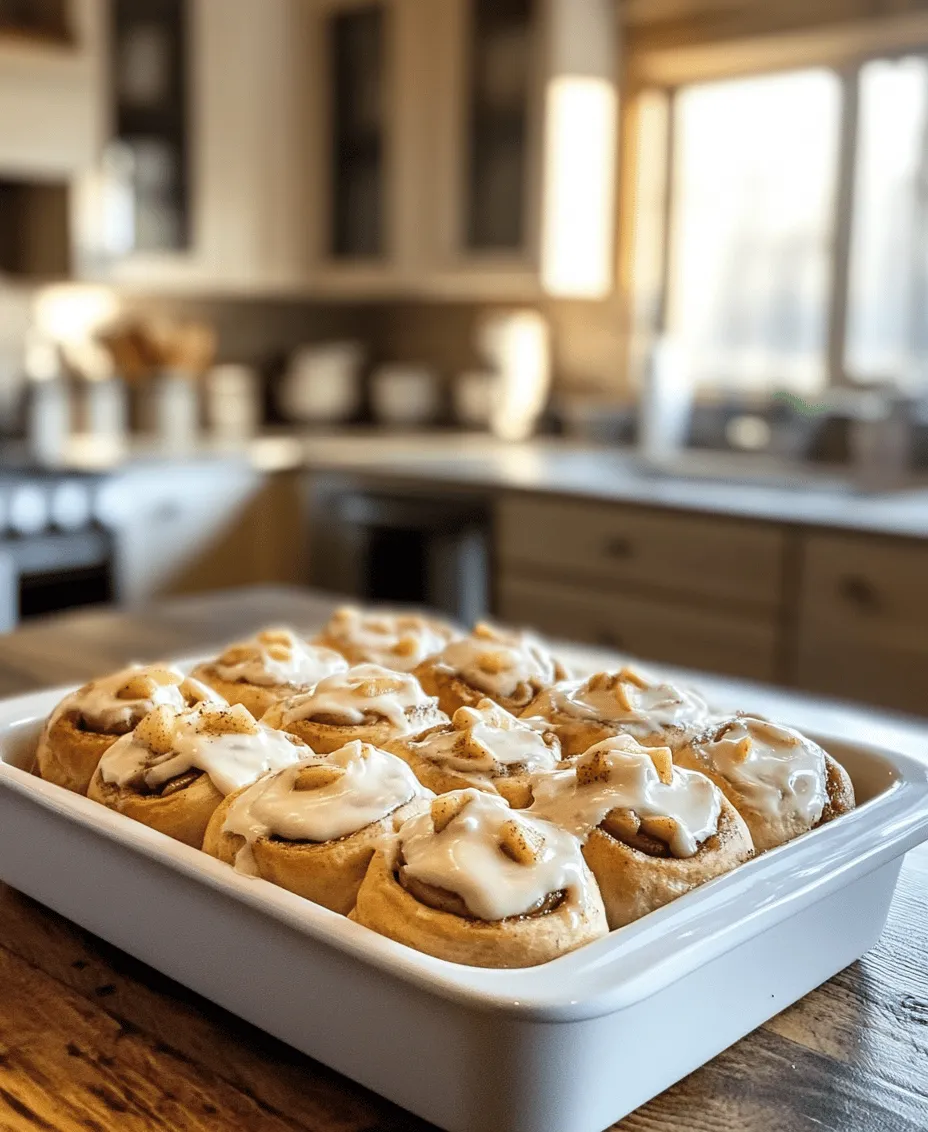Introduction
There’s something undeniably comforting about the aroma of freshly baked apple cinnamon rolls wafting through your kitchen. With their soft, pillowy texture, sweet apple filling, and the rich, creamy decadence of cream cheese frosting, these rolls are a delightful treat for any occasion. Whether you’re waking up to a leisurely weekend breakfast, hosting a cozy brunch with friends, or simply craving a sweet indulgence, homemade apple cinnamon rolls are sure to please.
The combination of warm spices, tender apples, and creamy frosting creates a symphony of flavors that not only comforts the soul but also tantalizes the taste buds. Imagine biting into a fluffy roll that melts in your mouth, each layer bursting with the sweet, tart flavor of apples and the warm notes of cinnamon. It’s a culinary experience that’s hard to resist, making these rolls a perfect centerpiece for gatherings or a simple afternoon delight.
Understanding the Ingredients
Key Ingredients Overview
Creating the perfect apple cinnamon rolls starts with understanding the essential ingredients that contribute to their delightful flavors and textures. This recipe showcases a few key components that make these rolls truly irresistible.
– Flour: All-purpose flour serves as the backbone of the dough, providing structure and a fluffy texture. The right amount of flour is crucial for achieving the perfect balance between softness and stability.
– Yeast: Active dry yeast is responsible for the dough’s rise, creating that light and airy quality we all love in cinnamon rolls. Yeast fermentation is what allows the dough to expand and become fluffy.
– Sugar: Both granulated sugar and brown sugar play a role in sweetness and moisture. Brown sugar, in particular, brings a deeper flavor with its molasses content, enhancing the overall taste of the filling.
– Apples: Fresh, crisp apples are the star ingredient in the filling. Varieties like Granny Smith or Honeycrisp add the perfect balance of sweetness and tartness, ensuring that each bite bursts with apple flavor.
– Cinnamon and Nutmeg: These warm spices are essential for creating that nostalgic flavor profile we associate with apple cinnamon rolls, adding depth and warmth to the filling.
– Cream Cheese: The cream cheese frosting elevates these rolls to a new level of indulgence. Its creamy texture and slight tanginess perfectly complement the sweetness of the rolls and filling.
Importance of Fresh Apples
When it comes to the filling, the quality of your apples can make a significant difference in the overall flavor and texture of your cinnamon rolls. Fresh, crisp apples not only provide a delightful crunch but also retain their shape during baking, preventing them from turning mushy. Choosing the right apple variety is essential; tart apples like Granny Smith contrast beautifully with the sweetness of the sugar and the warmth of the cinnamon, creating a balanced and flavorful filling.
Role of Yeast in Creating Fluffy Dough
Yeast is a living organism that ferments sugars, producing carbon dioxide gas and alcohol. This process is what causes the dough to rise and develop that signature fluffy texture. Using warm milk and melted butter helps activate the yeast, allowing it to work effectively. It’s important to ensure that the liquid isn’t too hot, as excessive heat can kill the yeast, resulting in a dense, unappetizing roll.
Cream Cheese Frosting Enhancing the Flavor Profile
No apple cinnamon roll is complete without a generous layer of cream cheese frosting. This decadent addition not only provides a creamy contrast to the warm rolls but also adds a slight tang that balances the sweetness of the filling. The smooth texture of the frosting makes it easy to spread over the rolls, completing this comforting treat.
Preparing the Dough
Step-by-Step Guide to Making the Dough from Scratch
Making dough from scratch may sound daunting, but it’s a rewarding process that yields delicious results. Here’s a detailed guide to help you create the perfect dough for your apple cinnamon rolls.
1. Gather Your Ingredients: Start by gathering all your ingredients. You’ll need all-purpose flour, sugar, salt, active dry yeast, warm milk, melted butter, and eggs. Having everything ready will make the process smoother.
2. Activate the Yeast: In a small bowl, combine 1 cup of warm milk (about 110°F or 43°C) with 2 tablespoons of sugar and 2 1/4 teaspoons of active dry yeast. Stir gently and let it sit for about 5-10 minutes until it becomes frothy. This step ensures that your yeast is active and ready to help your dough rise.
3. Mix the Dough: In a large mixing bowl, combine 4 cups of all-purpose flour and 1 teaspoon of salt. Create a well in the center and add the frothy yeast mixture, along with 1/4 cup of melted butter and 1 beaten egg. Mix until the dough starts to come together.
4. Knead the Dough: Transfer the dough onto a floured surface and knead for about 8-10 minutes, until it becomes smooth and elastic. If the dough is sticky, sprinkle a little additional flour as needed. Proper kneading is crucial for developing gluten, which gives the dough its structure.
5. Let the Dough Rise: Shape the kneaded dough into a ball and place it in a lightly greased bowl, covering it with a clean kitchen towel or plastic wrap. Allow it to rise in a warm, draft-free area for about 1-2 hours, or until it doubles in size. This resting period is essential for allowing the yeast to work its magic.
Tips for Kneading the Dough
Kneading dough is a tactile process that can be quite enjoyable. Here are some tips to ensure you achieve the right texture:
– Flour your surface lightly: Too much flour can make the dough dry, while too little can make it stick. Use just enough to keep the dough from sticking to your hands and the work surface.
– Use the right technique: Push the dough away from you with the heel of your hand, then fold it back over itself, giving it a quarter turn. Repeat this process to effectively develop gluten.
– Know when to stop: The dough is ready when it feels smooth and elastic and springs back when pressed gently with your finger.
Creating the Apple Filling
Description of Apple Filling Ingredients
Once your dough has risen, it’s time to prepare the flavorful apple filling. The ingredients for the filling include fresh apples, brown sugar, cinnamon, nutmeg, and a touch of lemon juice. Each of these components plays a vital role in creating a deliciously sweet and spiced filling.
– Fresh Apples: As mentioned earlier, using a combination of tart and sweet apples enhances the flavor and texture of the filling. Dice them into small, uniform pieces for even cooking.
– Brown Sugar: Brown sugar contributes to the gooeyness of the filling while adding a rich, caramel-like flavor that pairs perfectly with apples.
– Cinnamon and Nutmeg: These spices are the heart of the filling. Cinnamon provides warmth and sweetness, while nutmeg adds a subtle depth of flavor that elevates the overall profile.
– Lemon Juice: A splash of lemon juice brightens the filling and helps prevent the apples from browning, ensuring a fresh taste.
Techniques for Preparing Apples
To prepare your apples for the filling, follow these simple steps:
1. Peel and Core the Apples: Start by peeling the apples and removing the cores. This will help ensure that the filling has a smooth texture and avoids any unwanted chunks.
2. Dice Uniformly: Cut the apples into small, even pieces. This allows them to cook evenly and ensures that every bite of the cinnamon roll is filled with delicious apple flavor.
3. Toss with Sugar and Spices: In a bowl, combine the diced apples with brown sugar, cinnamon, nutmeg, and lemon juice. Toss to coat the apples evenly, allowing the flavors to meld together before spreading them over the dough.
The Role of Spices in Complementing the Apples
The spices used in the filling are essential for enhancing the natural sweetness of the apples. Cinnamon is a classic pairing, providing warmth and familiarity, while nutmeg adds a hint of earthiness. Together, they create a comforting flavor that evokes the essence of cozy fall days, making these cinnamon rolls a perfect treat throughout the year.
Rolling and Shaping the Rolls
Instructions on Rolling Out the Dough
Once your dough has risen and your filling is ready, it’s time to roll out the dough and shape it into rolls. Here’s how to do it:
1. Prepare Your Surface: Lightly flour your work surface to prevent sticking.
2. Roll the Dough: Turn the risen dough out onto the floured surface and gently punch it down to release any air bubbles. Using a rolling pin, roll the dough into a large rectangle, approximately 1/4 inch thick. Aim for about 16×24 inches in size for optimal roll thickness.
Tips on Spreading the Filling Evenly
To ensure that each roll is filled with delicious apple goodness, follow these tips:
– Spread the Filling Generously: Use a spatula to spread the apple filling evenly over the rolled-out dough, leaving a small border around the edges.
– Avoid Overfilling: While it may be tempting to pile on the filling, too much can cause the rolls to spill out during baking. Moderation is key for achieving perfect cinnamon rolls.
Importance of Sealing the Edges
After spreading the filling, it’s essential to roll the dough tightly and seal the edges to keep the filling inside. Here’s how to do it:
1. Roll from the Long Side: Starting from one of the longer sides of the rectangle, carefully roll the dough away from you, keeping it tight as you go.
2. Seal the Edge: Once rolled, pinch the seam tightly to seal the roll. This will prevent the filling from leaking out during baking.
By following these steps, you’ll create beautifully shaped apple cinnamon rolls that are sure to impress. The combination of fresh apples, warm spices, and creamy frosting makes these rolls a delightful treat that is perfect for any occasion. In the next part of this article, we will cover the final steps of baking and frosting your irresistible apple cinnamon rolls, so stay tuned!

The Second Rise: Why It Matters
The second rise, often referred to as proofing, is a crucial step in the process of making apple cinnamon rolls. After shaping the dough and rolling it with the apple filling, allowing it to rise again is essential for achieving that light, fluffy texture we all crave in cinnamon rolls. During this phase, the yeast continues to do its job, producing carbon dioxide that causes the dough to expand. If you skip this step, your rolls may end up dense and chewy instead of soft and pillowy.
To create the ideal conditions for the second rise, find a warm, draft-free area in your kitchen. Cover the rolls with a clean kitchen towel or plastic wrap to retain moisture. An excellent spot for this is near a preheated oven or in a slightly warmed oven turned off. Aim for a temperature around 75°F to 80°F for optimal yeast activity. Depending on the ambient temperature, this rise can take anywhere from 30 minutes to 1 hour, or until the rolls have doubled in size.
Baking the Apple Cinnamon Rolls
Once your rolls have completed their second rise, it’s time to move on to baking them to golden perfection. Preheat your oven to 350°F (175°C) at least 20 minutes before you plan to bake. This ensures that your rolls will begin baking immediately upon entering the oven, allowing for even cooking.
Place the rolls in a greased baking pan, ensuring they are spaced out to allow for further expansion as they bake. If you’ve rolled them tightly, they should still have space to rise a little more in the oven. Keep an eye on the baking time; your apple cinnamon rolls will typically need 20 to 25 minutes in the oven. Look for a gorgeous golden-brown color and a puffed-up appearance. You can gently press the top of a roll; if it springs back, they are done.
After removing them from the oven, it’s crucial to allow the rolls to cool slightly before frosting. This pause not only prevents the cream cheese frosting from melting off but also helps to set the rolls, enhancing their flavor and texture.
Making the Cream Cheese Frosting
While your apple cinnamon rolls are cooling, you can prepare the creamy, dreamy frosting that tops them. For the frosting, you’ll need room temperature cream cheese, unsalted butter, powdered sugar, and a splash of vanilla extract. Begin by beating the cream cheese and butter together in a mixing bowl until the mixture is smooth and creamy. This step is essential for ensuring there are no lumps in your frosting.
Next, gradually add in the powdered sugar while continuing to mix. This approach prevents a sugary cloud from forming and keeps your kitchen tidy. Once the sugar is incorporated, add the vanilla extract. The frosting should have a spreadable consistency; if it feels too thick, you can add a teaspoon of milk or cream to achieve the desired texture.
The balance of flavors in the frosting is vital. The tanginess of the cream cheese complements the sweetness of the rolls perfectly, creating a harmonious blend that elevates the entire dish. If you want to experiment with flavors, consider adding a splash of maple syrup or a hint of cinnamon to the frosting for an extra layer of taste.
Frosting the Rolls
With your rolls slightly cooled and your cream cheese frosting ready, it’s time to bring your apple cinnamon rolls to life. Using a spatula, dollop a generous amount of frosting onto each roll. For even coverage, start from the center and work your way outwards, allowing the frosting to cascade over the sides. This method not only looks beautiful but also ensures every bite is bursting with flavor.
Serving your apple cinnamon rolls warm is recommended, as the frosting will melt slightly into the warm dough, enhancing the overall experience. However, they are equally delightful at room temperature, making them perfect for brunch gatherings or dessert tables. For an extra touch, consider garnishing the rolls with a sprinkle of cinnamon or a handful of chopped nuts, such as pecans or walnuts, for added texture and flavor.
Serving Suggestions
Apple cinnamon rolls are incredibly versatile and can be enjoyed in various ways. Pair them with a steaming cup of coffee or a soothing herbal tea for a delightful breakfast or brunch experience. They also make a sweet ending to any meal, serving as a comforting dessert that everyone will love.
When presenting your apple cinnamon rolls, consider using decorative plates or serving them in a charming basket lined with a cloth napkin. This rustic presentation adds to the homemade feel and makes for an inviting display at your table.
If you have leftovers (which is rare but possible), store them in an airtight container at room temperature for up to 2 days. For longer storage, you can freeze the rolls, placing them in a freezer-safe bag, where they will last for approximately a month. To reheat, simply pop them in the microwave for 15-20 seconds or place them in a preheated oven at 350°F for about 10 minutes, ensuring they’re warmed through.
Conclusion
There’s something undeniably joyful and satisfying about making and enjoying homemade apple cinnamon rolls. The process, from kneading the dough to the intoxicating aroma that fills your kitchen while they bake, brings a sense of warmth and nostalgia that can brighten even the gloomiest of days. With their soft, pillowy texture and the sweet, tangy cream cheese frosting, these rolls are not just a treat; they are an experience meant to be shared with family and friends.
We encourage you to try this recipe for yourself, as the delight of pulling a tray of warm, fragrant apple cinnamon rolls from the oven is unmatched. Whether it’s a special occasion or just a regular Sunday morning, these rolls promise to deliver a delightful experience that combines warmth and sweetness, making them a cherished addition to your recipe repertoire. So gather your ingredients, roll up your sleeves, and get ready to create a delicious memory that will linger long after the last roll has been devoured.



